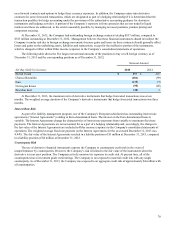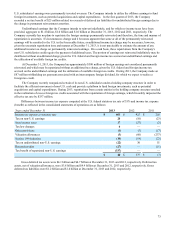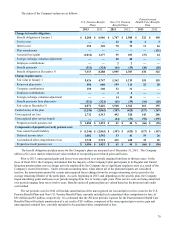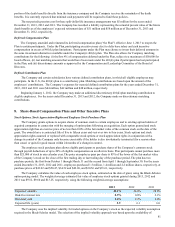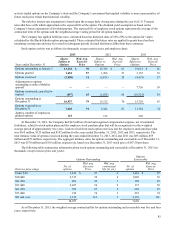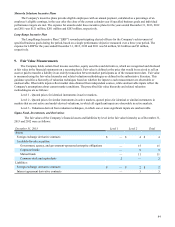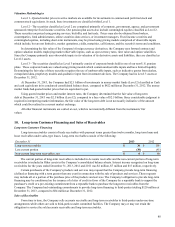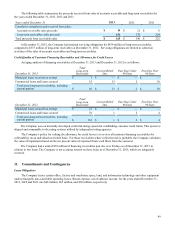Motorola 2013 Annual Report Download - page 82
Download and view the complete annual report
Please find page 82 of the 2013 Motorola annual report below. You can navigate through the pages in the report by either clicking on the pages listed below, or by using the keyword search tool below to find specific information within the annual report.
80
Investment Policy
The Company has adopted an investment policy designed to meet or exceed the expected rate of return on plan assets
assumption. To achieve this, the plans retain professional investment managers that invest plan assets in equity, fixed income
securities, and cash equivalents. In addition, some plans invest in insurance contracts. The Company uses long-term historical
actual return experience with consideration of the expected investment mix of the plans’ assets, as well as future estimates of
long-term investment returns, to develop its expected rate of return assumption used in calculating the net periodic cost. The
Company has target mixes for these asset classes for all plans, which are readjusted periodically when an asset class weighting
deviates from the target mix, with the goal of achieving the required return at a reasonable risk level.
The weighted-average asset allocations by asset categories for all pension and the Postretirement Health Care Benefits
Plans were as follows:
All Pension Benefit Plans Postretirement Health Care
Benefits Plan
December 31 2013 2012 2013 2012
Target Mix:
Equity securities 55% 64% 57% 65%
Fixed income securities 43% 35% 42% 34%
Cash and other investments 2% 1% 1% 1%
Actual Mix:
Equity securities 55% 64% 58% 64%
Fixed income securities 42% 34% 40% 32%
Cash and other investments 3% 2% 2% 4%
Within the equity securities asset class, the investment policy provides for investments in a broad range of publicly-traded
securities including both domestic and foreign equities. Within the fixed income securities asset class, the investment policy
provides for investments in a broad range of publicly-traded debt securities including U.S. Treasury issues, corporate debt
securities, mortgage and asset-backed securities, as well as foreign debt securities. In the cash and other investments asset class,
investments may be in cash, cash equivalents or insurance contracts.
Cash Funding
The Company contributed $150 million to its U.S. Pension Benefit Plans during 2013, compared to $340 million
contributed in 2012. The Company expects to make cash contributions of approximately $300 million to its U.S. Pension
Benefit Plans and approximately $35 million to its Non-U.S. Pension Benefit Plans in 2014. The Company does not expect to
make cash contributions to the Postretirement Health Care Benefits Plan in 2014.
Expected Future Benefit Payments
The following benefit payments are expected to be paid:
Year U.S. Pension
Benefit Plans
Non U.S.
Pension
Benefit Plans
Postretirement
Health Care
Benefits Plan
2014 $ 286 $ 41 $ 25
2015 298 42 24
2016 312 43 23
2017 328 44 22
2018 347 46 21
2019-2023 2,097 245 96
Other Benefit Plans
Split-Dollar Life Insurance Arrangements
The Company maintains a number of endorsement split-dollar life insurance policies that were taken out on now-retired
officers under a plan that was frozen prior to December 31, 2004. The Company had purchased the life insurance policies to
insure the lives of employees and then entered into a separate agreement with the employees that split the policy benefits
between the Company and the employee. Motorola Solutions owns the policies, controls all rights of ownership, and may
terminate the insurance policies. To effect the split-dollar arrangement, Motorola Solutions endorsed a portion of the death
benefits to the employee and upon the death of the employee, the employee’s beneficiary typically receives the designated


